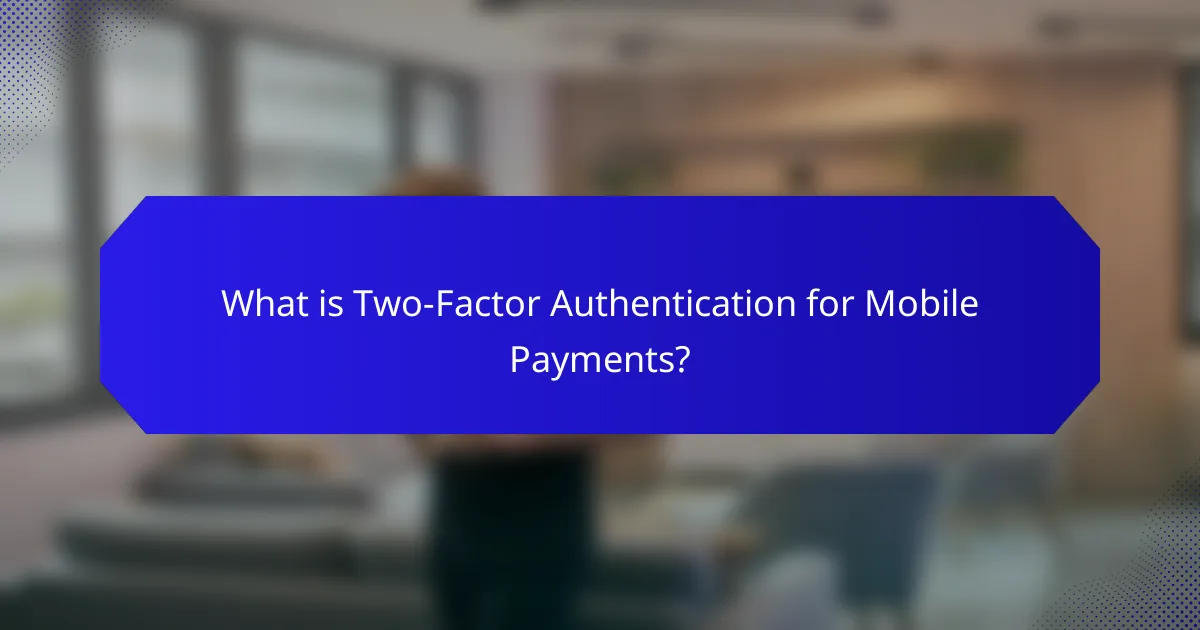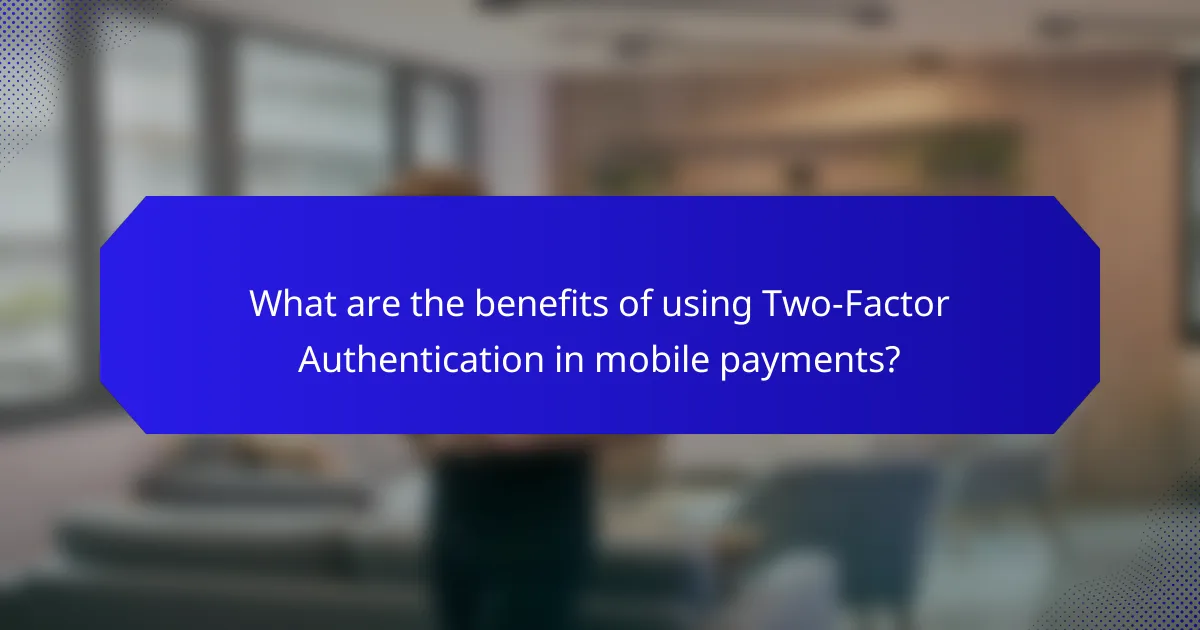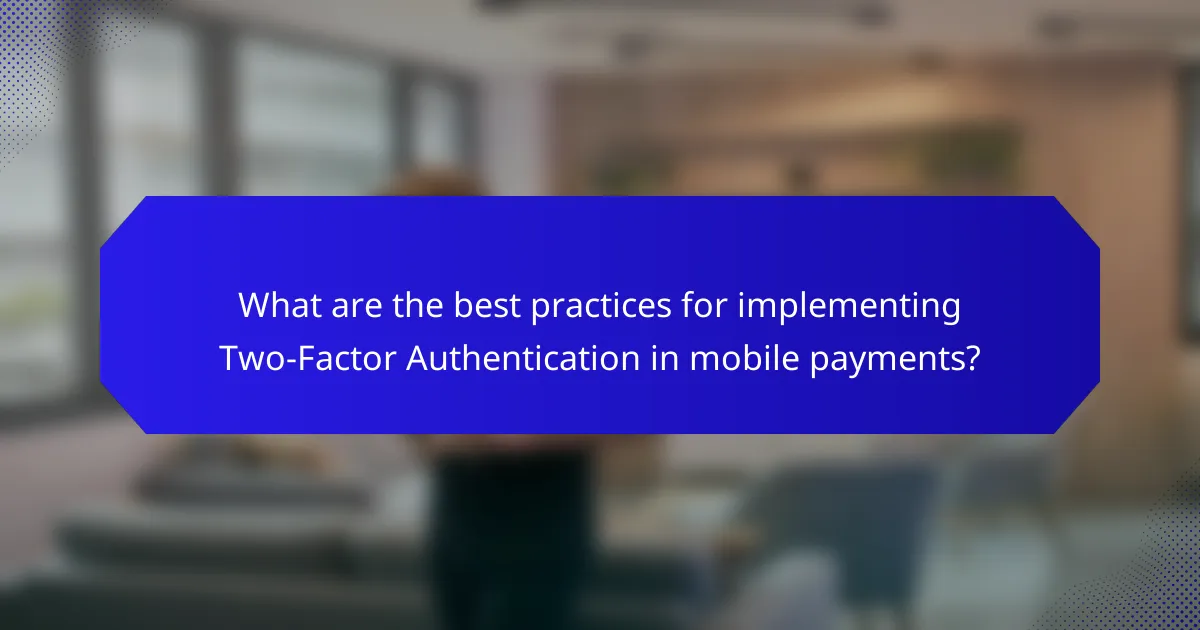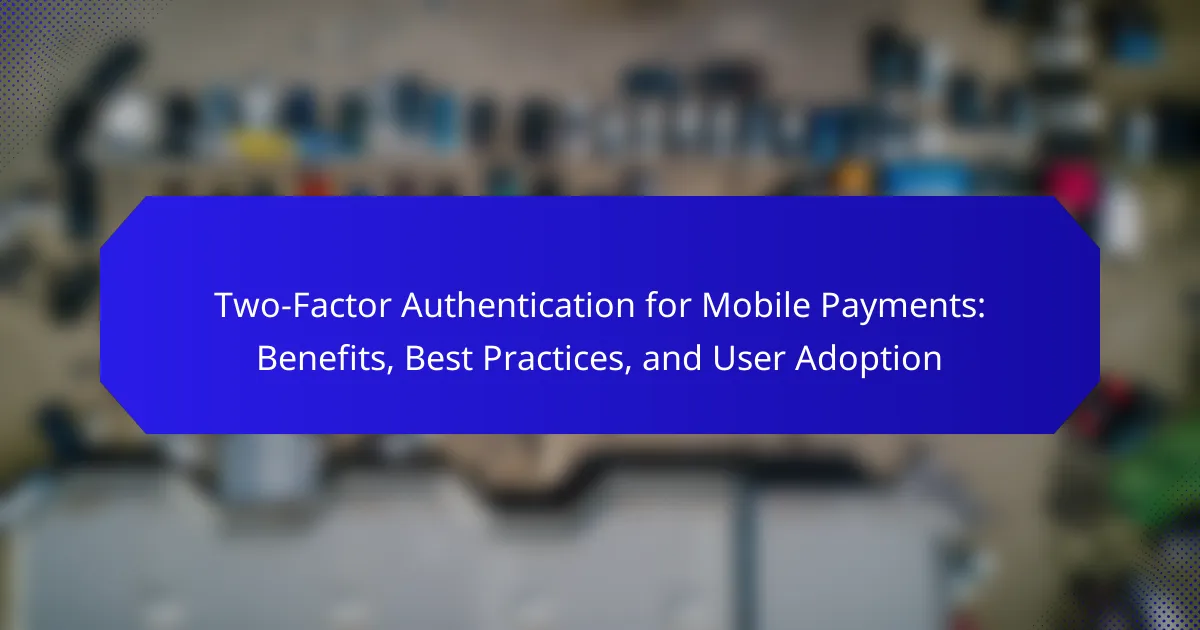Two-Factor Authentication (2FA) is a critical security measure for mobile payments that requires users to provide two distinct forms of verification to complete a transaction. This process typically involves a combination of something the user knows, such as a password or PIN, and something the user possesses, like a smartphone or hardware token. The implementation of 2FA significantly decreases the likelihood of unauthorized access to payment accounts, with studies indicating it can block up to 99.9% of automated cyberattacks. Best practices for utilizing 2FA include employing time-based one-time passwords (TOTPs), biometric verification, and secure backup methods. User education on the significance of 2FA is also essential for promoting its adoption and enhancing overall security in mobile payment systems.

What is Two-Factor Authentication for Mobile Payments?
Two-Factor Authentication (2FA) for mobile payments is a security process that requires two forms of verification before a transaction is completed. The first factor is typically something the user knows, like a password or PIN. The second factor is usually something the user possesses, such as a smartphone or a hardware token. This dual verification significantly reduces the risk of unauthorized access to payment accounts. According to a study by the Cybersecurity and Infrastructure Security Agency, using 2FA can block up to 99.9% of automated cyberattacks. Thus, 2FA enhances the security of mobile payment systems by adding an extra layer of protection against fraud.
How does Two-Factor Authentication enhance security in mobile payments?
Two-Factor Authentication (2FA) enhances security in mobile payments by requiring two forms of verification before granting access. This process typically combines something the user knows, like a password, with something the user has, such as a mobile device. By implementing 2FA, unauthorized access is significantly reduced. According to a study by Google, 2FA can block 100% of automated bots and 99% of bulk phishing attacks. This added layer of security ensures that even if a password is compromised, the account remains protected. As a result, mobile payment transactions become more secure against fraud and identity theft.
What are the key components of Two-Factor Authentication?
The key components of Two-Factor Authentication (2FA) are something you know and something you have. The first component is a password or PIN that the user knows. This is the primary method of authentication. The second component is a physical device or token that the user possesses. This could be a smartphone, hardware token, or biometric identifier. Together, these components enhance security by requiring two forms of verification. According to the Cybersecurity & Infrastructure Security Agency, 2FA significantly reduces the risk of unauthorized access. This dual-layer approach ensures that even if one factor is compromised, the account remains protected.
How does user verification occur in Two-Factor Authentication?
User verification in Two-Factor Authentication (2FA) occurs through a two-step process. The first step requires the user to enter their username and password. This is the initial verification step, confirming the user’s identity.
The second step involves a second form of identification. This could be a code sent to the user’s mobile device or an authentication app. The user must enter this code to complete the verification process.
This method significantly enhances security. According to a 2020 study by Google, 2FA can block up to 100% of automated bot attacks. This demonstrates the effectiveness of Two-Factor Authentication in protecting user accounts.
Why is Two-Factor Authentication important for mobile payment users?
Two-Factor Authentication (2FA) is important for mobile payment users because it adds an extra layer of security. This process requires users to provide two forms of identification before accessing their accounts. The first factor is typically a password, while the second factor can be a text message code or authentication app notification. This dual requirement significantly reduces the risk of unauthorized access. According to a study by Google, 2FA can block 100% of automated bots and 96% of phishing attempts. By implementing 2FA, mobile payment users can protect their sensitive financial information from theft and fraud.
What risks are mitigated by implementing Two-Factor Authentication?
Two-Factor Authentication (2FA) mitigates several risks associated with unauthorized access to accounts. It significantly reduces the likelihood of account takeover by requiring a second form of verification. This second factor can be a text message code or an authentication app prompt.
Phishing attacks are less effective against accounts protected by 2FA. Even if a user’s password is compromised, the attacker would still need the second factor to gain access. Additionally, 2FA helps protect sensitive financial information during mobile payments.
According to a report by Google, 2FA can block up to 100% of automated bots and 96% of bulk phishing attacks. This statistic underscores the effectiveness of 2FA in enhancing account security. Overall, implementing 2FA provides a robust layer of protection against various cyber threats.
How does Two-Factor Authentication protect sensitive financial information?
Two-Factor Authentication (2FA) protects sensitive financial information by requiring two forms of verification. This process enhances security beyond just a password. The first factor is typically something the user knows, like a password. The second factor is usually something the user has, such as a mobile device or a hardware token.
By demanding both factors, 2FA significantly reduces the risk of unauthorized access. Even if a password is compromised, the attacker would still need the second factor to gain entry. According to a study by Google, the implementation of 2FA can block 99.9% of automated attacks. This statistic highlights the effectiveness of 2FA in safeguarding financial data.

What are the benefits of using Two-Factor Authentication in mobile payments?
Two-Factor Authentication (2FA) enhances security in mobile payments. It requires users to provide two forms of verification before accessing their accounts. This significantly reduces the risk of unauthorized access. According to a study by Google, 2FA can block 99.9% of automated attacks. It adds an extra layer of protection beyond just a password. Users must enter a one-time code sent to their device. This makes it harder for hackers to compromise accounts. Additionally, 2FA can increase user confidence in mobile payment systems. Enhanced security measures often lead to higher adoption rates among users.
How does Two-Factor Authentication improve user trust?
Two-Factor Authentication (2FA) improves user trust by adding an extra layer of security. This additional step requires users to verify their identity through a second method, such as a text message or authentication app. By doing so, 2FA significantly reduces the risk of unauthorized access to accounts.
Research shows that 2FA can prevent up to 99.9% of automated attacks. Many users feel more secure knowing their accounts are protected by this method. A 2021 study by Google found that 2FA protects over 85% of compromised accounts.
Implementing 2FA fosters a sense of safety among users. This increased confidence can lead to higher user engagement and loyalty. As a result, businesses that adopt 2FA often see improved customer satisfaction.
What evidence supports increased user confidence with Two-Factor Authentication?
Two-Factor Authentication (2FA) significantly increases user confidence in online security. A study by Google found that 2FA can block 100% of automated bot attacks and 99% of phishing attacks. This statistic highlights the effectiveness of 2FA in protecting user accounts. Additionally, a report from the Ponemon Institute states that organizations implementing 2FA experience a 50% reduction in account compromise incidents. This reduction enhances user trust in the security of their transactions. Furthermore, users report feeling more secure when using services that offer 2FA, as indicated by a survey from LastPass. This survey revealed that 86% of users believe 2FA improves their online security. These pieces of evidence collectively demonstrate that 2FA fosters greater user confidence in digital transactions.
How do businesses benefit from enhanced user trust?
Businesses benefit from enhanced user trust by increasing customer loyalty and retention. Higher trust leads to more repeat purchases. Customers are more likely to recommend trusted businesses to others. Enhanced trust can also result in higher conversion rates. A study by PwC found that 59% of consumers would share personal data with a trusted brand. Additionally, businesses with strong trust profiles often see improved brand reputation. This can lead to better market positioning. Ultimately, enhanced user trust translates into increased revenue and growth opportunities.
What are the cost implications of implementing Two-Factor Authentication?
Implementing Two-Factor Authentication (2FA) incurs several cost implications. Initial setup costs may include software purchases or subscription fees for 2FA services. Ongoing operational costs arise from maintaining the system and providing user support. Training staff to manage 2FA processes can also add to expenses.
According to a study by the Ponemon Institute, the average cost of a data breach is $3.86 million, highlighting the potential savings from implementing 2FA. Additionally, organizations may face indirect costs related to user experience and potential friction during the authentication process.
Overall, while there are upfront costs, 2FA can lead to significant long-term savings by reducing the risk of security breaches.
How does Two-Factor Authentication impact operational costs?
Two-Factor Authentication (2FA) can increase operational costs for businesses. Implementing 2FA requires investment in technology and infrastructure. This includes purchasing software and hardware to support the authentication process. Training employees to use 2FA also incurs costs. Additionally, customer support may require more resources to assist users with authentication issues.
However, 2FA can reduce costs related to fraud and data breaches. According to a study by the Ponemon Institute, organizations that implement strong authentication measures can save an average of $1.3 million annually from avoided data breach impacts. Thus, while initial costs may rise, long-term savings can offset these expenses.
What is the return on investment for businesses using Two-Factor Authentication?
The return on investment for businesses using Two-Factor Authentication (2FA) is significant. Implementing 2FA can reduce the risk of data breaches by up to 99.9%. This leads to substantial cost savings, as the average cost of a data breach is approximately $3.86 million. Businesses that adopt 2FA often see a decrease in fraud-related losses. Furthermore, enhanced security can improve customer trust and retention. Studies show that 81% of data breaches are due to weak or stolen passwords. Therefore, investing in 2FA not only protects sensitive information but also strengthens overall business integrity.

What are the best practices for implementing Two-Factor Authentication in mobile payments?
The best practices for implementing Two-Factor Authentication (2FA) in mobile payments include using time-based one-time passwords (TOTPs), biometric verification, and secure backup methods. TOTPs generate unique codes that change every 30 seconds, enhancing security. Biometric verification, such as fingerprint or [censured] recognition, provides a user-friendly and secure authentication method. Secure backup methods, like recovery codes, ensure users can regain access if they lose their primary 2FA method.
Additionally, educating users about the importance of 2FA is crucial. Studies show that users are more likely to adopt security measures when they understand their benefits. Regularly updating authentication methods and software is also essential to protect against emerging threats. Implementing these practices can significantly reduce the risk of unauthorized access in mobile payment systems.
How can businesses effectively integrate Two-Factor Authentication?
Businesses can effectively integrate Two-Factor Authentication (2FA) by implementing it during user login processes. This adds an extra layer of security beyond just passwords. First, businesses should choose reliable 2FA methods, such as SMS codes, authenticator apps, or biometrics. Next, they must ensure that users are educated about the importance of 2FA. Clear instructions on enabling 2FA should be provided to users.
Additionally, businesses should regularly test their 2FA systems for vulnerabilities. According to a study by the Cybersecurity & Infrastructure Security Agency, 2FA can block up to 99.9% of automated attacks. Regular updates to the 2FA methods are also crucial to maintain security. Finally, businesses should monitor user feedback to improve the 2FA experience continuously.
What steps should be taken during the implementation process?
Identify the objectives of the two-factor authentication implementation. Establish clear goals such as enhancing security and improving user trust. Assess the current mobile payment infrastructure. Review existing systems to determine compatibility with two-factor authentication. Choose the appropriate two-factor authentication method. Options include SMS codes, authentication apps, or biometric verification. Develop a comprehensive implementation plan. Outline steps, timelines, and responsible parties for each phase. Conduct a risk assessment to identify potential vulnerabilities. Address any security gaps before proceeding. Test the two-factor authentication system thoroughly. Perform pilot testing with a small user group to gather feedback. Train users on the new system. Provide clear instructions and support to facilitate adoption. Monitor the implementation process closely. Track performance metrics to ensure objectives are being met. Adjust the strategy as necessary based on user feedback and system performance.
How can user experience be optimized while using Two-Factor Authentication?
User experience can be optimized while using Two-Factor Authentication (2FA) by implementing user-friendly methods for verification. Utilizing biometric authentication, such as fingerprint or [censured] recognition, simplifies the process. This method reduces the need for users to remember and input codes. Offering backup codes or recovery options ensures users can regain access if they lose their primary method.
Streamlining the authentication flow minimizes the steps required for verification. For instance, integrating 2FA into the app’s login process can enhance efficiency. Providing clear instructions and feedback during the authentication process helps users feel confident and informed.
Research indicates that simplifying 2FA can lead to higher user adoption rates. A study by Google found that user-friendly 2FA methods can increase security without sacrificing convenience. By focusing on these aspects, organizations can enhance user experience while maintaining robust security measures.
What common mistakes should be avoided when using Two-Factor Authentication?
Common mistakes to avoid when using Two-Factor Authentication (2FA) include using weak secondary authentication methods. Many users rely on SMS codes, which can be intercepted. Another mistake is failing to enable 2FA on all accounts that support it. This leaves some accounts vulnerable. Users often neglect to update their recovery options, which can complicate account recovery. Additionally, sharing 2FA codes with others is risky and should always be avoided. Lastly, not using unique passwords for each account can undermine the effectiveness of 2FA. According to the Cybersecurity & Infrastructure Security Agency, implementing 2FA significantly reduces the likelihood of unauthorized access.
What are the pitfalls of poorly designed Two-Factor Authentication systems?
Poorly designed Two-Factor Authentication (2FA) systems can lead to significant security vulnerabilities. These systems may implement weak or easily guessable second factors, such as SMS codes, which can be intercepted. Additionally, if the user experience is cumbersome, users may disable 2FA, reducing overall security. Poorly designed interfaces can confuse users, leading to incorrect entries and lockouts. Moreover, reliance on outdated technology can leave systems open to attacks. According to a 2021 report by the Cybersecurity & Infrastructure Security Agency, 76% of organizations faced security incidents due to ineffective 2FA implementations. Thus, inadequate design can compromise the intended protection of 2FA systems.
How can organizations ensure compliance with regulations regarding Two-Factor Authentication?
Organizations can ensure compliance with regulations regarding Two-Factor Authentication (2FA) by implementing robust security protocols. They should adopt industry standards such as NIST SP 800-63 for identity assurance. Regularly updating authentication methods is essential to align with evolving regulatory requirements. Training employees on 2FA practices enhances compliance and security awareness. Conducting audits and assessments helps identify vulnerabilities in the 2FA implementation. Organizations must maintain clear documentation of their 2FA policies and procedures to demonstrate compliance. Additionally, utilizing automated compliance monitoring tools can streamline adherence to regulations. Compliance with regulations enhances trust and security in mobile payment environments.
What strategies can increase user adoption of Two-Factor Authentication?
To increase user adoption of Two-Factor Authentication (2FA), organizations should implement user education programs. These programs should inform users about the security benefits of 2FA. Clear communication about how 2FA protects personal and financial information is crucial.
Additionally, simplifying the setup process can enhance adoption rates. A user-friendly interface encourages users to enable 2FA. Offering multiple authentication methods, such as SMS, email, or authenticator apps, provides flexibility.
Incentives can also motivate users to adopt 2FA. For instance, offering discounts or rewards for enabling 2FA can drive participation. Regular reminders about the importance of 2FA can keep it top of mind for users.
Lastly, showcasing statistics on fraud prevention linked to 2FA can strengthen its perceived value. Research indicates that accounts with 2FA are significantly less likely to be compromised.
How can organizations educate users about the benefits of Two-Factor Authentication?
Organizations can educate users about the benefits of Two-Factor Authentication (2FA) through various strategies. They can offer training sessions that explain how 2FA enhances security. Providing clear, concise materials such as brochures or infographics can help users understand its importance. Online webinars can also be effective in reaching a wider audience. Additionally, organizations can share real-world examples of security breaches that could have been prevented with 2FA. Regular reminders via email or notifications can keep the topic fresh in users’ minds. Engaging users through interactive content, like quizzes or videos, can make learning more appealing. Finally, organizations should encourage user feedback to improve educational efforts.
What incentives can encourage users to adopt Two-Factor Authentication?
Incentives to encourage users to adopt Two-Factor Authentication (2FA) include enhanced security, convenience, and potential rewards. Enhanced security protects accounts from unauthorized access. According to a report by Google, 2FA can block 100% of automated bots and 99% of bulk phishing attacks. Convenience can be improved through seamless integration with existing platforms. Additionally, offering rewards such as discounts or loyalty points can motivate users. For example, financial institutions often provide incentives to customers who enable 2FA. These strategies collectively promote user adoption of 2FA.
What troubleshooting tips are available for common issues with Two-Factor Authentication?
To troubleshoot common issues with Two-Factor Authentication (2FA), first ensure the correct phone number or email is linked to the account. Verify that the device used for 2FA has a stable internet connection. Check if the time and date settings on the device are accurate, as discrepancies can cause authentication failures. If using an authentication app, confirm it is updated to the latest version. Restart the device to resolve temporary glitches. Clear the app cache or reinstall the app if issues persist. If receiving SMS codes, ensure the mobile network is functioning properly. Lastly, contact customer support if problems continue, as they can provide account-specific assistance.
Two-Factor Authentication (2FA) for mobile payments is a security measure that requires two forms of verification to enhance transaction safety. This article covers the benefits of 2FA, including its ability to block a significant percentage of cyberattacks, and outlines best practices for implementation to improve user trust and adoption. Key components of 2FA, such as user verification methods and the importance of educating users about security, are discussed in detail. Additionally, the article addresses common challenges and troubleshooting tips associated with 2FA to ensure effective implementation in mobile payment systems.
